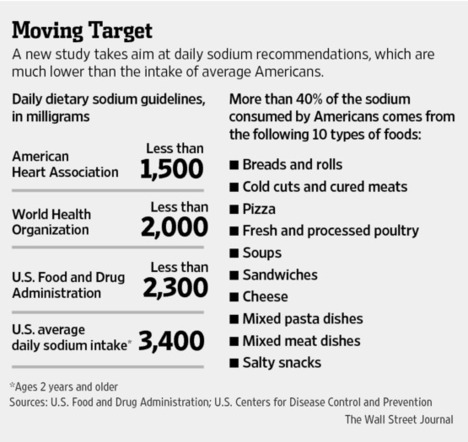 Source of graphic: online version of the WSJ article quoted and cited below.
Source of graphic: online version of the WSJ article quoted and cited below.
(p. A1) A long-running debate over the merits of eating less salt escalated Wednesday when one of the most comprehensive studies yet suggested cutting back on sodium too much actually poses health hazards.
Current guidelines from U.S. government agencies, the World Health Organization, the American Heart Association and other groups set daily dietary sodium targets between 1,500 and 2,300 milligrams or lower, well below the average U.S. daily consumption of about 3,400 milligrams.
The new study, which tracked more than 100,000 people from 17 countries over an average of more than three years, found that those who consumed fewer than 3,000 milligrams of sodium a day had a 27% higher risk of death or a serious event such as a heart attack or stroke in that period than those whose intake was estimated at 3,000 to 6,000 milligrams. Risk of death or other major events increased with intake above 6,000 milligrams.
The findings, published in the (p. A2) New England Journal of Medicine, are the latest to challenge the benefit of aggressively low sodium targets–especially for generally healthy people. Last year, a report from the Institute of Medicine, which advises Congress on health issues, didn’t find evidence that cutting sodium intake below 2,300 milligrams reduced risk of cardiovascular disease.
For the story, see:
RON WINSLOW. “Low-Salt Diets May Pose Health Risks, Study Finds.” The Wall Street Journal (Thur., Aug. 14, 2014): A1-A2.
(Note: the online version of the story has the date Aug. 13, 2014, an has the title “Low-Salt Diets May Pose Health Risks, Study Finds.”)

